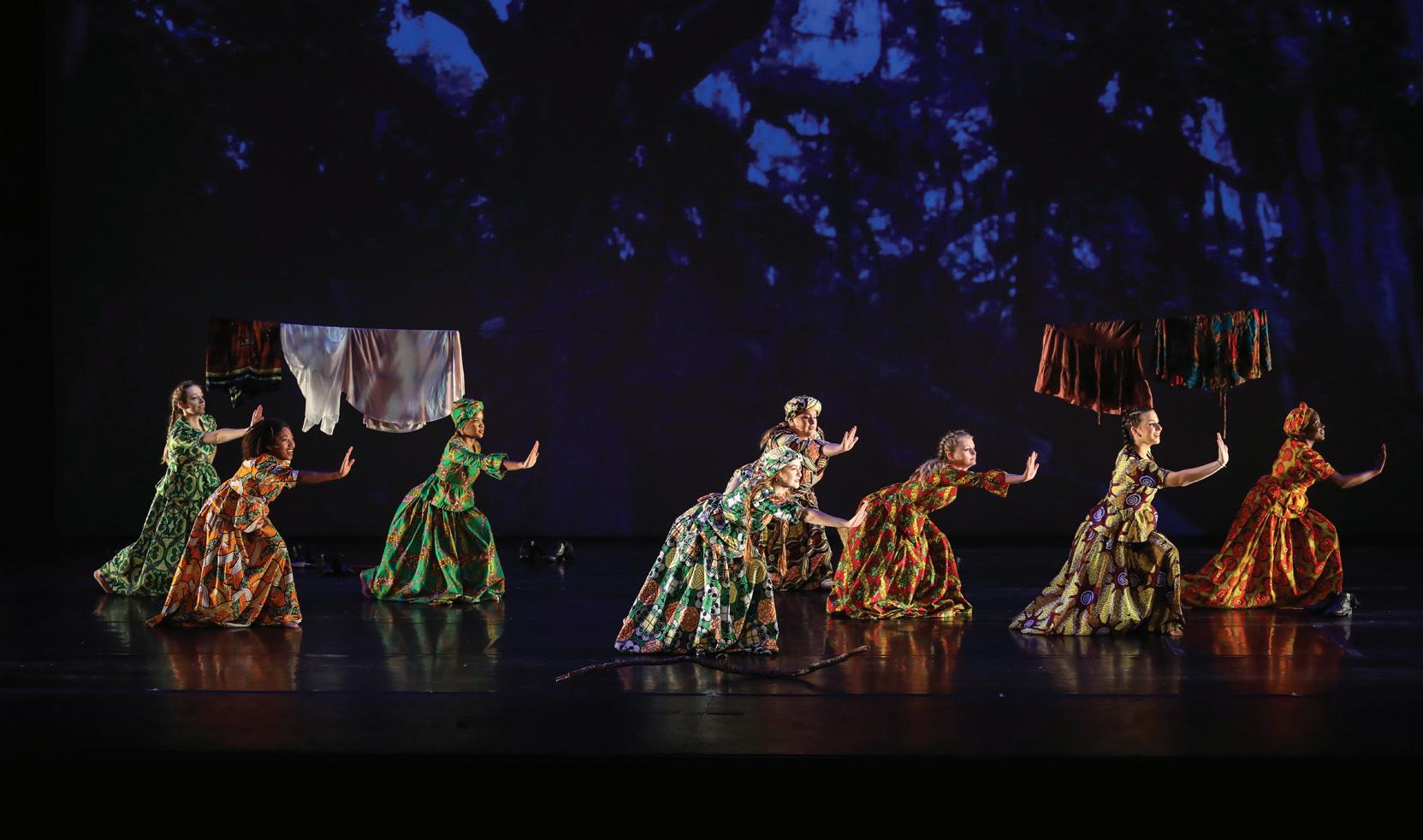
7 minute read
Bring Back the Ring Shout
Tamara Williams pays homage to the enslaved with upcoming dance showcase
BY LEA BEKELE
Any other year, UNC Charlotte assistant professor of dance Tamara Williams would be training her students, readying them to leave it all on the stage during the upcoming annual fall dance showcase, a live performance that acts as the culmination of what the class has learned throughout the semester. But 2020 isn’t any other year.
In fact, this year Williams is utilizing three stages unlike any the showcase has seen before. Oh, and there is no live performance, no audience, and most of the work is already done.
When Williams and the Dance department began planning for the showcase, they had to keep COVID-19 restrictions in mind, as we’ve all learned that you can’t make any assumptions about whether the virus will let up. The department decided to broadcast this year’s performances live on Zoom so the audience can watch safely from their homes.
While all but one of the performances will be carried out live on stage for the virtual event, Williams decided to do things differently, partnering with Charlotte filmmaker Marlon Morrison and five of her dance students to create a documentarystyle video showcasing their performance of the traditional Ring Shout dance, first practiced by African people enslaved in the West Indies and United States. The class filmed its performances on the banks of the Catawba River, in front of the historic Siloam School, and at the only remaining slave dwelling in Mecklenburg County.
Williams has professional experience with dozens of styles of dance that span an array of cultures, all of which have ties to the African diaspora. For the Fall 2020 Virtual Dance Concert, Tamara Williams chose to shed light on the Ring Shout style in the pre-recorded piece, which she titled “Remembrance” in memory of the enslaved and descendants of the enslaved who once utilized and inhabited these spaces.
The film aims to take the viewer on a journey of different locations through movement, song, nature and rhythm. In an effort to preserve the original movements and gestures of the tradition, Williams made it her goal to reconstruct the earliest records of Ring Shout dancing and teach them to her students.

A RING SHOUT DANCE DURING ‘REMEMBERING CYCLES’ AT UNC CHARLOTTE’S 2017 FALL DANCE CONCERT.PHOTO BY JEFF CRAVOTTA
Dance of the diaspora
The African diaspora describes what came of the mass transportation and subsequent enslavement of the African peoples during the Transatlantic Slave Trade. The diaspora consists of descendants of millions of people taken from western and central Africa and dispersed to different regions including the Americas and the Caribbean over the span of three centuries.
Modern-day Black people of the same ancestral background have no way of knowing the details of their relation due to that separation.
The African diaspora remains as relevant as ever today, as Black people around the world seek a connection to their lineage.
The Ring Shout traditions originated in communities of enslaved people throughout the South, including the Carolinas, that practiced the dance almost exclusively as a religious experience in which worshipers moved in a circle while shuffling and stomping their feet and clapping.
As an homage to the past, part of the “Remembrance” dance was filmed outside of the Siloam School, a 1920s school for Black children in Charlotte built in the same vein as Rosenwald Schools of the early 20th century. Another part of the performance takes place at Mecklenburg County’s last standing slave cabin. The third piece of the performance takes place on the banks of the Catawba River, symbolic of the coastlines where Ring Shout dancing was most popular.
Williams’ desire to film in these locations came from a prior trip to Charleston, where she visited multiple plantations and performed alongside dancers in that community. She was inspired by their movements, which she says brought a whole different element to the dance. Each choreographed piece was a love letter to the people that were there before them — those who may be gone but have not been forgotten, she says.
Throughout the rehearsal process, Williams asked her students to do research before they started the choreography of the piece. Each student was encouraged to look into their genealogical background and create movement in honor of their ancestors.
The elements of the video play a part in the overall meaning; earth, water, fire and air signify the connections the dance has with the afterlife. The group dancing in the water represents the act of rebirth and what Williams describes as the cleansing of communion. Earth is represented in the form of plants, which are used throughout the African diaspora for their medicinal purposes. “Remembrance” features movements that represent the gathering of herbs.
Though there is no physical representation of wind and fire in the film, both are also intertwined with the choreography through themes of transformation and determination that Williams weaved throughout the piece, she says.
Movements through the dance community
Williams started dancing when she was a child in Augusta, Georgia, first at Davidson Fine Arts, where she trained in West African dances, ballet, tap and jazz. That was her jumping-off point into the dance community. As a teen, two of her teachers encouraged her to study dance in undergrad, inspiring her decision to audition for the Florida State University dance program.
Williams spent the next four years in Tallahassee dancing at Florida State, where she eventually earned her BFA. She went straight into touring with Millicent Johnnie, owner of Millicent and Company, which afforded her the opportunity to dance for audiences across Florida, her home state of Georgia and parts of Texas.
From there, Williams went to New York where she stayed in the city for 15 years. She danced professionally with Urban Bush Women and Alpha Omega and fine-tuned her understanding of West African dances. “I started really getting interested in dancing movements that were inspired by African diaspora culture,” shares Williams.
Williams met Rosangela Silvestre who taught her the Silvestre Dance Technique, which originated in Brazil. Silvestre defines the practice as “a continuously evolving contemporary dance technique with the objective of conditioning the dancer through physical and expressive training regardless of level or previous experience.”
Williams traveled to Brazil for Silvestre’s dance intensive and eventually gained the choreographer’s blessing to teach others the technique.
It was then that Williams began traveling the world as a Silvestre instructor, until she started her own dance company called Moving Spirits, Inc. in 2011.
“The dance company is really dedicated to
documenting, preserving, teaching and performing dances of the African diaspora,” Williams explains.
She moved back to Charlotte in 2016 to be closer to her family and was brought on to teach dance at UNC Charlotte that year.
Marlon Morrison makes waves
Charlotte native Marlon Morrison’s interest in film began at the North Carolina School of the Arts where he studied theatre. After graduation, Morrison moved to New York to pursue acting after a friend there invited him to help create a film about racial profiling. He later returned to the Charlotte area and works as a teaching artist in local schools using theatre techniques and videography.
Morisson views creating films as a form of therapy.
“Instead of taking our aggression, why not channel that through film,” he tells Queen City Nerve.
With his My Voice, My Choice project, Morrison produced fictional films with area youth about real issues ranging from gang violence to homophobia to depression. Building on his experience with civic

TAMARA WILLIAMS PHOTO BY JEFF CRAVOTTA
engagement through creation, the project allowed him to take his film equipment into local schools and help students draft a story, write a script, rehearse and put their work to film.
“Doing something of significance made me want to do more work visually, as a storyteller,” Morrison says.
He had never heard of Ring Shout dancing until
he spoke to Meg Whalen with UNC Charlotte College of Arts + Architecture, who put him in contact with Williams, planting the seed of collaboration.
“Remembrance” was Morrison’s first experience with shooting a dance piece, though his theater background came in handy throughout the process.
“It’s not a dance video, it’s a performance piece,” he explains.
His biggest goal and challenge: to fully capture the spirit of the dance visually through film. His shots focused on the elongation of movement and walking a thin line so as not to overshadow the actual dancing with his production elements, he says.
Historically, the arts have had a huge role in civic responsibility and civic engagement, Williams points out, which is what she had in mind when she created a platform through her dance company.
As with Morrison, she wanted to give a voice to artists bringing up issues that affect their community and issues that may be affecting them as individuals. The group has participated in street protests as far back as 2014 after the shooting of Michael Brown.
“We can think back to these dances, like Ring Shout,” Williams says. “It’s a dance of resistance. It’s a dance of resiliency. It’s a dance of community.”
The “Remembrance” video will be released on Nov. 20 as part of UNC Charlotte’s Fall 2020 Virtual Dance Concert, along with four other performances taking place that night.




